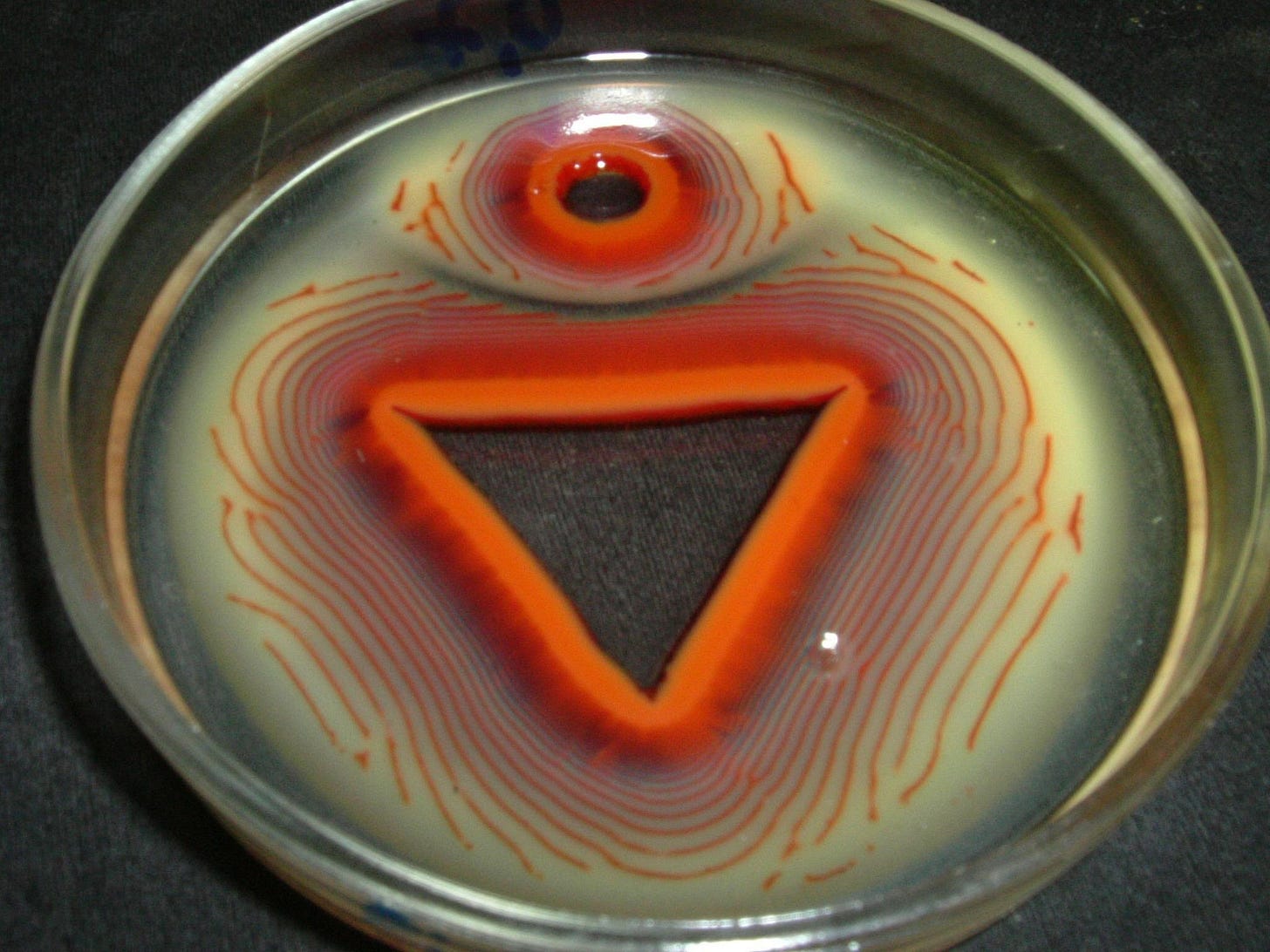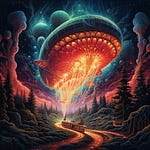Stormy Waters (@NormanDodd_knew on the X) and I continue our journey through the world of consciousness, trying to answer two questions:
What physics makes psi phenomena possible?
The first half is a completely autistic deep dive into alternative particle physics. I sperg out about Paul LaViolette’s theory of Subquantum Kinetics as a potential explanation for all of these seemingly impossible phenomena. This is dense stuff - prepare your shape-rotator muscles and prepare to hear some scientifically heinous claims. I may not have explained in the best way and at some points said wrong things, so at the bottom of these notes there are extensive explanations and links with timestamps to where they are mentioned in the episode.
Many of the explanations are pulled straight from LaViolette’s work, the texts I referenced you can find here.
What is the astral plane - how does it work, and who lives there?
In the second half, Stormy gives a thorough explanation of the astral realm. We discuss the mechanics, the rules, and what the the entire range of spirits that live there look like. He makes quite clear what the dangers of venturing inward are and how to prevent possession or worse. We also discuss what mysticism as a system is, how it differs from religion, and its historical contexts.
There are lots of fun little tangents and niche topics in between (The Painter, Tesla, Trump, spirits can smell?). I think you will thoroughly enjoy listening as much as I did recording. The notes below are quite in-depth, so feel free to stop and read a bit in between segments if some term escaped your grasp. My microphone was a bit blown out in the first half, so excuse the occasional clipping.
Segment Timestamps
00:00:56 Revenge of the Aether
The Physik behind psi phenomena and its integration with consciousness. We discuss existence of dynamic aether as foundational layer of reality, and introduce Paul LaViolette's Theorie of Subquantum Kinetics.
00:16:29 Brusselator Unter Allem
I explain aether as Brusselator nonlinear chemical oscillator. Etherons forming all matter as stable subquantum vibrational patterns. Matter begets matter, the universe evolves instead. Conservation of matter and Big Bang out of the window.
00:32:05 Oscillation is the Law
How matter and life dynamically interact in waves like complex BZ chemical systems. Power of cross-disciplinary systems thinking. Superluminal waves, Tesla controversy, and importance of scientific open-mindedness.
00:49:33 Quantum Universal Matrix
Here quantum entanglement is explained using SK. Entangled particles instantly affect each other regardless of distance, suggesting a foundational matrix connecting all particles since beginning of time - maybe mechanism for consciousness?
01:02:12 Mind over Matter
Life as the prime mover beyond matter (consciousness forcing evolution). Difference between spirituality and mysticism as scientific study. How parallel universes could exist. Extrasensory perception through subquantum communication.
01:20:23 Explicate Blindness
Limits of human perception, secrets of EM spectrum. Connecting Bohm-Broglie Pilot wave theory and implicate/explicate orders to SK. Introduction to subquantum realm as possible astral realm.
01:37:20 Hyperborean Egregores
Introduction to spiritual entities and egregores. Jung’s theory of The Painter as German Volk spirit incarnated literally. How egregores form through collective possession and historical examples post-WW1 Germany and the Iranian Revolution.
02:05:44 Astral-Olfactory Industrial Complex
Spirits' keen olfactory sense. The power of smells as astral tools, weaponized incense. The significance of ritual cleansing and offerings, many potential dangers of astral projection and taking psychodelische Drogen without initiation.
02:20:09 Tripping to the Zoo
Nature of entities as annoyed zoo animals - do not feed! Eastern vs Western mystical traditions, Daoism and Bible. Religion as hijacked diluted mysticism. Practices sober vs with drugs. Intention and sigil magicks. Discipline in exploration and dangers of deceptive demons.
02:42:50 Soul Boot Camp
Mystic tradition as spiritual scientific study. Zen Archery as unity of action. Understanding ourselves beyond the physical. Hierarchy of beings in astral plane and hazard rating. Dangers of mirrors when remote viewing, Stormy shares hair-raising personal story of encounter.
An interesting quote from an interview with Carl Jung from 1942.
Sources and Explanations
00:10:18 The experiment I referred to that disproved the existence of a fixed aether was the Michaelson-Morley Experiment - I incorrectly stated they used a magnetometer. Here is a short explanation:
The Michelson-Morley experiment, conducted in 1887 by Albert Michelson and Edward Morley, was a groundbreaking study designed to detect the existence of a luminiferous aether, a hypothetical medium thought to permeate space and carry light waves. The experiment used an interferometer, a device that splits a beam of light into two perpendicular paths and then recombines them, creating an interference pattern. The idea was that if the Earth was moving through the aether, the light traveling along the path parallel to the Earth's motion would take slightly longer than the light traveling perpendicular to it, resulting in a shift in the interference pattern. However, despite repeated attempts and increasingly precise measurements, Michelson and Morley found no evidence of this shift, indicating that the speed of light was constant in all directions and that there was no aether. This null result was a major puzzle for physicists at the time and ultimately contributed to the development of Albert Einstein's special theory of relativity, which postulated that the speed of light is constant in all inertial reference frames and that there is no absolute frame of reference.
00:12:58 We mentioned the Brusselator.
A Brusselator is a theoretical model of a chemical oscillator, which is a system that exhibits periodic variations in the concentrations of its chemical components over time. The Brusselator model was proposed by Ilya Prigogine and his colleagues in 1968 as a simplified representation of autocatalytic reactions. It consists of two coupled nonlinear differential equations that describe the evolution of two chemical species, typically denoted as X and Y. The Brusselator model demonstrates how a simple set of chemical reactions can give rise to complex oscillatory behavior and has been used to study various aspects of chemical dynamics, pattern formation, and self-organization in biological and chemical systems.
00:14:37 The etheron reactions modelled on a Brusselator are in the following image. These equations make up what LaViolette calls Model G. The k values for each reaction are the weights, or likelihoods that this reaction will occur.
When illustrated as a diagram, the system looks like this:
A system of differential equations can be written to express the concentration of X, Y and G in space:
00:18:42 The etherons create stable wave patterns much like the stable arrangements of chemical reactants in a Brusselator system.
00:22:44 Here we mention the “criticality“ of the system without really explaining what it means. In a Brusselator reaction, criticality refers to the point at which the system transitions from a stable steady state to an oscillatory state.
Steady state: At low concentrations of reactants, the Brusselator system remains in a stable steady state, where the concentrations of the chemical species remain constant over time.
Critical point: As the concentrations of the reactants increase, the system reaches a critical point. At this point, the steady state becomes unstable, and the system becomes sensitive to small perturbations.
Oscillations: Beyond the critical point, the concentrations of the chemical species begin to oscillate periodically. These oscillations arise due to the nonlinear feedback mechanisms in the autocatalytic reaction.
In Model G, the system's criticality is determined by the value of the G variable, or the spatial concentration of G etherons.
00:23:25 I state that in Model G, matter begets more matter. This is because the presence of matter implies a very low G potential well, and a large G concentration creates a high criticality. Since matter is just an stable oscillation in etherons, a higher criticality implies a faster transition to these oscillations from a stable state.
Sufficiently negative G potentials create supercritical conditions that allow matter formation and photon blueshifting while positive G potential values create subcritical conditions that cause tired-light photon redshifting and in extreme instances particle dematerialization.
In Brusselator-type systems, small random fluctuations in concentrations occur often. If the system is subcritical but close enough to the critical point, a large enough fluctuation could cause a local supercriticality. Because of the reverse reaction
a fluctuation in X (or Y, as they are linked) could cause G to sufficiently increase. Thus, a stable X, Y, G concentration is nucleated, which is just a particle. This process is shown below. The weight of the reverse reaction above is very small, which is why this doesn’t occur all the time.
00:26:13 We mention Thomas Townsend Brown, who researched electrogravitics. The Wikipedia page will of course deny this effect is real. There are some really great books on this topic, I recommend this one.
00:27:14 We discuss redshift and the tired-light theory. I mistakenly said redshift was because the light was losing energy, which is what SK predicts, but not our current understanding! Redshift is now attributed to the doppler effect of faraway light sources accelerating away from us.
00:29:13 I mention the evidence supporting the tired-light theory of redshift. LaViolette predicted a very small blueshift of light travelling through supercritical regions (where there is lots of matter), and this was observed in the Pioneer Effect.
00:32:56 Stormy sends me two pictures of BZ reactions that we discuss.
00:36:21 We mention the parallax method of measuring astronomical distances.
00:39:38 We discuss the evolution of galaxies according to the evolutionary model predicted by SK. Here is an illustration of what that looks like:
00:45:16 We mention Tesla and his scalar waves. Here is a more in-depth explanation.
00:51:02 We discuss quantum entanglement. To quickly explain, quantum entanglement is a phenomenon in which two or more particles become interconnected in such a way that their quantum states (their spin) cannot be described independently, even when the particles are separated by vast distances. When particles are entangled, measuring the state of one particle instantly affects the state of the other, regardless of the distance between them.
Experiment shows that when two electrons are brought into close proximity so that their spins adopt compatible parallel and antiparallel orientations, that the particles retain their spin orientation link even when separated by great distance. […] In the case of entangled photons, the polarization orientation of one photon has been observed to be linked to that of its partner even when the pair is separated by 18 kilometers, and the orientation of one has been determined to have been conveyed to the other at a speed in excess of 100,000c (Brumfiel, 2008).
00:55:16 When explaining how SK models quantum entanglement, I mention vortices that are interlocked. This is a vortex of the etheric flux, so of the movement of the etherons. Here they are drawn below.
I quickly stated that spin arises from these vortices, but some further clarification is required. The etheric flux at the point of contact between the particles must be in the same direction. They can either be aligned axially (like the triplet deuteron above), or parallel and antiparallel (like the singlet deuteron above). When the flows reinforce each other, the spins add up (a proton and neutron each have a spin of 1/2) - when they oppose each other, they are cancelled out as in the singlet deuteron.
00:57:48 I quickly mentioned a matrix connecting all particles without much explanation. Prepare for a deep dive…
Stable particles are a radially periodic concentration of X, Y and G etherons as shown below.
The crests and troughs of this pattern are essentially “shells“ of etheron concentrations. Because of the dynamic nature of etheron flux (remember, they are always in motion), etherons will constantly flow from one shell to another depending on the magnitude of the concentration (this is also what gives rise to the fluxes that create spin). It has been proposed that particles pulsate radially, although these pulses are difficult to detect experimentally. Such a pulsation would in effect shift the entire etheron concentration pattern inward and outward, and the information of these changes would be communicated almost instantaneously because etherons are not bound by the speed of light.
They would behave similarly to Tesla’s scalar waves. Such waves can be phase conjugated, which refers to the process where an outgoing longitudinal wave from a particle core is reflected back by an ionized region, creating a time-reversed wave that perfectly matches the original wave, forming a resonant, self-amplifying soliton beam connecting the particle core and the remote region, resulting in a "locked on" state.
Similar phase conjugate resonances may occur among subatomic particles due to the radial oscillation of their intersecting etheron concentration patterns.
These resonances could lead to the formation of interparticle soliton beams, which would connect particle cores into a vast matrix. The soliton beams would have relatively uniform wave amplitudes along their length, allowing entangled particles to experience each other's presence as if they were immediately adjacent, even when separated by large distances. Entangled particles would pulse in phase with one another, and changes in the spin alignment of one particle would affect its entangled partner, even over great distances. Additionally, these soliton beams could serve as force transfer conduits, conveying force at superluminal speeds and rapidly communicating events occurring at one point in the interconnected particle matrix to the entire entangled particle network.
Why does this all matter? According to the evolutionary model of the universe (matter being created inside large matter concentrations like stars), most of the matter in our galaxy was created in the Galactic core, Sgr A*. If these particles coexisted and possibly locked on to each other at some point, then they would all be entangled in some manner, instantaneously communicating force and information through undetectable subquantum waves.
Is it possible that this matrix of entanglements is the method of action for all the transcendent psi phenomena we have been describing? Could this be the source of things like universal consciousness, where all matter is bound to all other matter in seemingly mysterious ways? This final question is the entire reason to include Subquantum Kinetics in this episode - a potential physical mechanism for the transcendent.
01:12:49 I mentioned the possibility of parallel universes occurring alongside ours in the same physical space. This is possible in SK because of the definition of the etheron interactions that make up our own. Only the X, Y and G etherons create what we know as matter and energy, but they originate from initial etherons and transform into others. The question is, who knows how many types of etherons there may be higher and lower on this chain of reactions? Some of these may also organize in similar ways to the X, Y, G system and create entire universes located in the same physical space, but never interacting with ours, since “our“ etherons don’t interact with them.
A fun extra detail is that the passage of time could be considered the rate of etheron reactions (which we have no way of knowing or detecting). I find this superior to the thermodynamic definition of entropy since, if all the evidence for SK is correct, the universe is not a closed system, but an open one.
01:23:01 We discuss David Bohm’s theory of implicate and explicate orders. According to Bohm, the universe is divided into two domains:
Implicate Order (Enfolded Order): This is the deeper, hidden level of reality where everything is interconnected and enfolded into a unified whole. In this domain, time and space are not fundamental, and the distinctions between separate objects are less apparent. The implicate order is the source of all manifest reality and contains the information and potential for everything that exists in the explicate order.
Explicate Order (Unfolded Order): This is the manifest, observable level of reality that we perceive in our everyday experience. In the explicate order, things appear to be separate and distinct from one another, and time and space seem to be fundamental. This domain is characterized by the unfolding of the potentialities contained within the implicate order.
Bohm suggested that the relationship between the implicate and explicate orders is dynamic and cyclical. The explicate order emerges from the implicate order through a process called "explication" or "unfoldment," while the explicate order is simultaneously "enfolded" back into the implicate order. This process is continuous and occurs at every moment, creating the reality we experience.
This maps on nicely to the SK subquantum (where our “time“ is not passing, since it is defined by the reaction rate of the Model G etherons) and quantum domains. Here is more literature on Bohm-Broglie Theory.
01:28:10 We mention Warhammer 40k and its connection to egregores and consciousness. Stormy talks about the demon Nurgle in this universe, which may also be the ancient Sumerian demon called Nergal.
01:35:26 I read a quote from Carl Jung’s interview in 1942 called “Is Tomorrow Hitloor’s?“ The segment I read can be found on page 3 of the document.



























Share this post